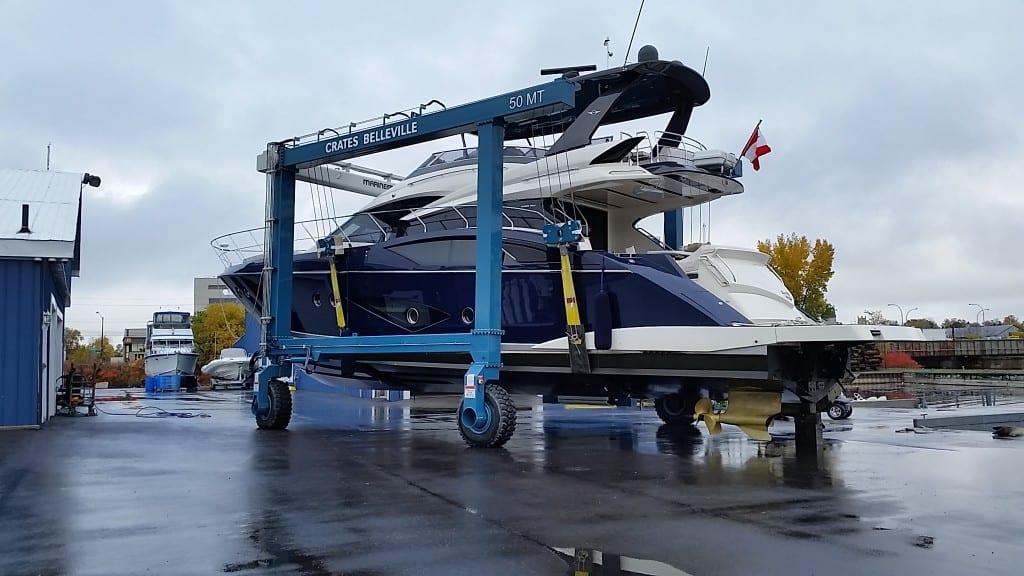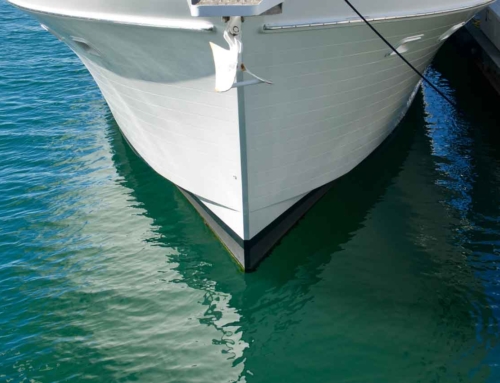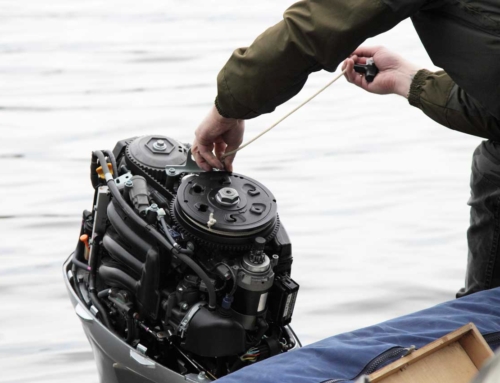After months of ice, sleet, and snow, “preparing your boat for spring” is the magic phrase that turns winter daydreams into launch-day reality. But spring commissioning isn’t just a box to check; it’s the difference between a season of worry-free cruising and weekends lost to surprise repairs. In this guide, we’ll walk you, step by step, through a proven spring-prep routine built for Ontario waters.
You’ll learn why a thorough inspection matters, how to deep-clean without harming the bay, and when to lean on the pros at Crate Marine Belleville. Follow along and you’ll be first in line when our marina spring launch crane splashes hulls in April.
1. Why Spring Prep Matters
Ontario winters are rough on fiberglass, fuel systems, and crew morale. Freezing temps shrink rubber hoses, salt spray crystallizes on metal fittings, and stale fuel quietly forms varnish inside your carburetor. Skipping preparing your boat for spring can turn a simple day on the Bay of Quinte into a tow-home nightmare.
- Safety first — A cracked exhaust hose can leak carbon monoxide; a worn belt can seize an alternator.
- Save money — Replacing a twenty-dollar impeller now beats buying a three-thousand-dollar powerhead later.
- More water time — Boats that launch early snag the best slips and fishing spots.
Remember, even a brand-new vessel needs a post-winter health check. Think of it as a physical exam for your favorite toy.

2. The Ultimate Pre-Launch Inspection Checklist
Grab this list, a notepad, and a warm mug of coffee. Work from bow to stern, outside to inside.
Hull & Exterior
- Visual scan – Circle the hull slowly, looking for blisters, hairline cracks, or chalky gel-coat.
- Through-hulls – Exercise every seacock. Lubricate the ball and make sure handles move freely.
- Anodes – If more than 40 % is gone, replace them; galvanic corrosion speeds up in early thaw.
- Anti-fouling paint – Touch up bald spots; zebra-mussel season arrives fast.
- Rudder and prop – Check for dents, pitting, or bent blades. Roll the prop shaft to spot wobble.

Engine & Fuel System
- Oil & filter – Condensation might have dripped in during storage. Fresh oil equals fresh start.
- Fuel treatment – Add stabilizer if you skipped it last fall. Ethanol blends separate under freezing temps.
- Belts & hoses – Look for glazing, cracking, or softness. Replace at the first hint of wear.
- Cooling system – Inspect impeller vanes, flush antifreeze, and refill with clean coolant.
- Fuel lines – Squeeze primer bulbs; if they feel mushy or leave black residue on fingers, they need swapping.
Electrical & Electronics
- Batteries – Charge to 100 % and perform a load test; 12.6 V at rest is your benchmark.
- Connections – Remove corrosion with baking-soda paste, rinse, then apply dielectric grease.
- Navigation gear – Install software updates and back up waypoints to a memory card or cloud drive.
- Lights – Confirm all nav, anchor, and interior lights shine bright.
Safety Gear & Paperwork
- PFDs – Check zippers and CO₂ cartridges (for inflatables).
- Flares – Must be within expiry; stash them in a dry, labeled container.
- Fire extinguishers – Shake monthly to loosen powder; gauge needle should stay in the green.
- Docs – Keep registration and insurance copies on board; fines in Ontario can top $250.
3. Deep-Clean Like a Pro
Dust, mildew, and seagull gifts thrive in closed cabins. Start at the top and work down:
- Ceilings & lockers – Use a vinegar-water spray to wipe away condensation stains.
- Upholstery – Vacuum first, then treat vinyl with a UV-blocking conditioner.
- Non-skid decks – Scrub with a pH-neutral cleaner to keep grit but lose grime.
- Brightwork – Polish stainless with microfiber towels; no steel wool—ever!
Bonus tip: clean carpets after cabinets. Gravity will dump dust on fresh rugs if you reverse the order.
4. Eco-Friendly Waste Disposal Tips
We share these waters with loons, bass, and families on paddleboards. Dispose of oil, coolant, and used filters at certified depots or our on-site Ontario boatyard recycling kiosk. Don’t toss expired flares in household trash—turn them in during our April marina spring launch event.
Crate Marine Belleville also offers:
- Free bilge-sock recycling
- Mercury-safe battery drop-off
- Compostable shrink-wrap collection
Protecting the environment protects boating for everyone.
5. Book Your Marina Spring Launch with Crate Marine Belleville
Why wrestle with a rusty trailer when our 50-ton travel-lift splashes your boat in minutes?
What’s included?
- Pressure-wash hull and running gear
- Inspect sacrificial anodes
- 15-point safety walk-through with a certified technician
- Fresh-water system flush and test
Slots fill fast once temperatures hit double digits. Reserve online or call 613-123-4567 to secure your preferred weekend. Early birds often enjoy a free coffee and pastry from our dockside café—a sweet reward while you watch the first drop into the bay.

6. DIY vs. Professional Service—What’s Best for You?
Paying a tech may cost less than replacing a seized lower unit. If in doubt, grab advice from our crew—many trained at Ganges Marina Services and bring decades of experience to Belleville.
7. Weather-Wise Spring Checklist (Extra Value)
Ontario’s spring weather is famously moody. Keep gear handy for quick switches:
- Foul-weather jackets – Sudden squalls still pack a chill in April.
- Dock lines with spring stretch – Rising water levels can tension static ropes.
- Spare bilge pump fuse – Meltwater intrusion is common on early-season runs.
- Portable heater – Nights dip near freezing; a 500-watt cabin heater saves soggy morale.
This seasonal gear list—rarely mentioned in competitor blogs—ensures comfort no matter what the forecast throws at you.
8. Quick-Start Spring Boating Checklist
- Charge and test all batteries.
- Inspect hull, polish, and wax.
- Replace engine fluids and filters.
- Inspect belts, hoses, and clamps.
- Test bilge pump and float switch.
- Update electronic charts and software.
- Inventory emergency gear.
- Book your marina spring launch slot.
- File a float plan before first voyage.
- Enjoy the season!
Print this page and tape it to your cabin door—check marks here equal carefree days on the water later.
Final Thoughts
By now it’s clear that preparing your boat for spring is about more than turning the ignition after the thaw. A thorough inspection of the hull, engine, electronics, and safety gear now will protect both your wallet and your weekends once the Bay of Quinte bursts back to life. Walk through the checklists you’ve just read, note any repairs or upgrades you can’t tackle alone, and line up professional help before the April rush. At the same time, collect used oil, coolant, and expired flares so you can drop them at our eco-friendly disposal kiosk on your next visit.
Once your to-do list is trimmed and your parts are in hand, book a spot in Crate Marine Belleville’s marina spring launch schedule. Early reservations guarantee the most convenient times and include our free 15-point safety walk-through—an extra set of seasoned eyes to catch small issues before they become big headaches. Keep an eye on the forecast, too; three consecutive nights above 5 °C is the sweet spot for splash-in without freeze-thaw risks.
With those final pieces in place, you can swap winter tarps for open horizons and enjoy Ontario’s waterways from Belleville to the Thousand Islands, confident that your boat is ready for anything the season brings. Need parts, advice, or just a friendly chat over fresh coffee on the dock?








